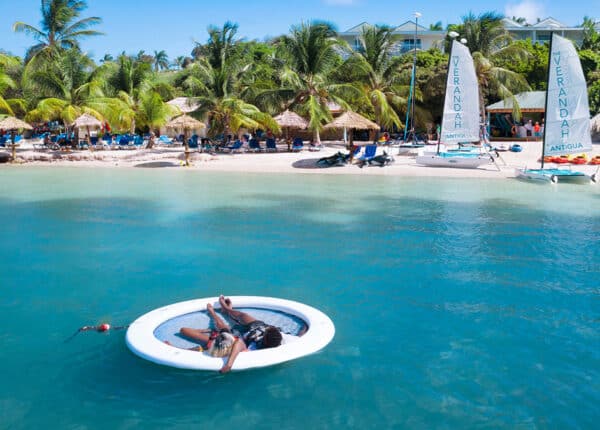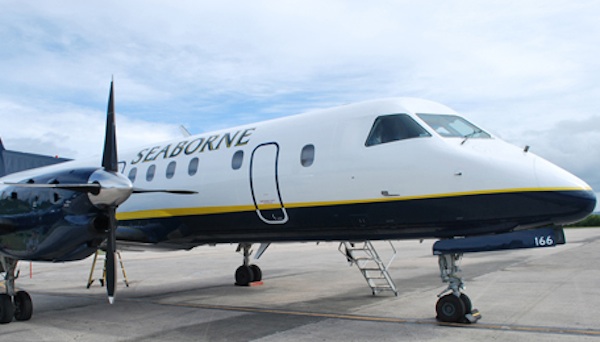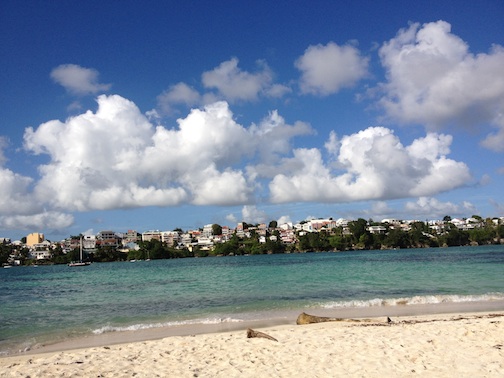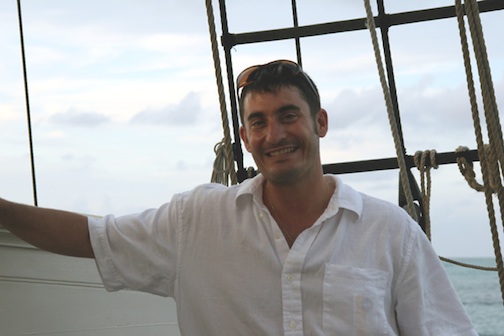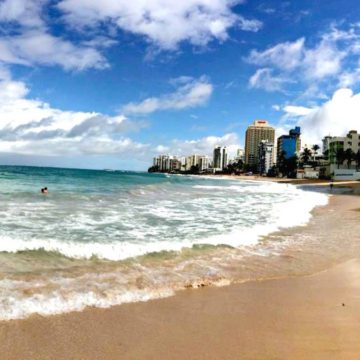Interview With Seaborne Airlines CEO Omer ErSelcuk
Above: a Seaborne plane
By Alexander Britell
With the departure of American Eagle from the Caribbean, the region’s aviation industry continues to change. But while many predicted doom, airlines large and small, from Cape Air to JetBlue, are working to fill the void and create a dynamic industry going forward. One of those is Seaborne Airlines, which has been expanding its fleet and service to emerge as a major regional carrier. Continuing Caribbean Journal’s series on Caribbean aviation, we talked to Omer ErSelcuk, CEO of St Croix-based Seaborne, about Eagle’s departure, the company’s new destinations and the biggest challenges for Caribbean airlift.
Talk about the recent growth of Seaborne.
On the first of April, we literally doubled the size of the airline overnight. We went from 600 seats per day to about 1,400 seats per day, in terms of what we’re offering for sale out there. And the primary aspect to that was the addition of the Saab 340B 34-passenger turboprop to the fleet. We started out with three aircraft, primarily operating out of San Juan to St Thomas, St Croix, Tortola and also to Dominica. And then on the first of June, we will add, of course, Fort de France and Point a Pitre, on a four days per week schedule. Both destinations will be served on Saturday. At this point, and additional to that, we have other routes which are flying with Twin Otter equipment, which subsequently can be a regional airline but can also get in and out of short fields, from San Juan to Virgin Gorda once everyday, and also allows us a seaplane series, we do between St Thomas and St Croix, which allows us literally to have people that fly every day — they live in St Thomas and work in St Croix or vice versa, and check in and get on a flight from your house in less than 20 minutes if you plan it just right.
What kind of partnership does Seaborne have with American Airlines?
We’re also in our second month of interline connections with American Airlines. We just added that in February, and it’s working very well in terms of driving traffic to Seaborne, and essentially allows our guests to be able to through-check their bags on Seaborne. We’re also working towards the ability to offer through-boarding passes and that should be coming down the pike. In addition, we’re looking at several other airlines. American has the most capacity in San Juan, but JetBlue is going to surpass them in the next few weeks, and we want to be able to connect with these carriers on an interline basis. So that sort of says who we are right now, and as you can imagine, for a company to double in in size overnight, what we’re doing right now is digesting that huge change, and it has been operating very well. In terms of reliability, there have been a few hiccups here and there, but we want to make sure the processes we put in place are well honed. It looks like we need to bring on more people to handle the level of traffic we’re seeing, which is a good thing. And we’ve also noticed there are some areas in terms of our systems and key personnel that we need to fortify. So the next few weeks are really going to be involved with fine tuning this big jump in size we’ve made. And while that’s happening on the operational front, we’re looking at the addition of at least three more aircraft, more likely four, by the end of the year.
Talk about the departure of American Eagle from the region.
I think that American Eagle has performed a vital service to the region by speeding up commerce through the regular and consistent provision of capacity for people to get back and forth. And San Juan is very much the centre of the Caribbean. It’s not only a connecting point to and from the rest of the world, particularly the US, but it’s also a hub of goods and services — not just for people to shop, but for people to go to the doctor for specialist work, that need to go to the hospital. There are also specialist engineers and mechanics that need to get out there and work on equipment for a week. So you have a lot of people that travel back and forth. And you add the local traffic, somebody who lives in St Croix but has family in St Kitts or St Lucia. So American Eagle has a legacy in addition to feeding American and providing great connections and begin the engine of commerce.
What does their departure mean for existing carriers?
In their departure, there is a responsibility for the airlines that are in the region to pick up and ensure the Caribbean doesn’t become less competitive than the rest of the world, in terms of air transport. Because a ferry system won’t work — the oceans are too rough, the price of fuel is too high and the islands are too far apart. And ferries have failed in just about every part if the world if they haven’t been subsidized. So the airline system is extremely important, in terms of filling that vacuum. I think the Caribbean is very fortunate in a number of circumstances. While AA has reduced the hub in San Juan from, at one time, over 200 flights, to the point where we’re seeing about 30 flights a day, that opens up the door for JetBlue to come in and lower the cost structure and offer a great product to backfill, on a stateside basis, just about everything American was providing in San Juan. And the rest of the major partners have done something similar. So what you have in terms of American’s pullback, particularly out of San Juan, it’s been replaced, and in a good way, because now that JetBlue has focused on San Juan, and they call it a focus city, they’re interested in adding down-island flying. They have St Maarten, St Thomas and St Croix, and several destinations in the Dominican Republic, and with their [Embraer] E190s, they fill a practical need that was previously served by American Eagle.
How do you see Seaborne and the other carriers competing with one another?
Cape Air is a critical factor in terms of the capacity they have provided. And Seaborne has expanded in probably the most aggressive manner starting out with San Juan. We added almost 500 seats a day in and out of San Juan. So that’s the equivalent of an Airbus A380 coming in, in terms of capacity that we have added into San Juan. And that’s just the beginning. If you combine Seaborne, LIAT, and Cape Air, what we’re going to see is flying that was dependent on one carrier is now going to be spread out among a group of carriers that are healthy competitors and, in some cases, provide a superior product to what you had before. And that is a great development. Because that means that the commerce system which is fueled by air transport is not going to go away.
You’ve mentioned the addition of Martinique and Guadeloupe. What kind of potential do you foresee for the French West Indies?
Well it’s a fairly large market — the size of the population on the island is significant. They also have a product that is very different from the rest of the Caribbean in that it’s a little bit more developed. Yet it offers all of the things people want — the sun, sand and sea and the hiking and the nature aspect, and, if you want to experience a little bit of France in the Caribbean, you can do that. That’s not something that has been lost on us. And with American Airlines starting service on Saturdays to both of those islands, people will naturally migrate to try check those services out, because they’re in such a huge distribution network, with all the online travel agencies well as aa.com. I think their service on Saturdays benefits us, because if folks do not want to do a full week vacation, they’ll be flying there to and from on Seaborne, just by having the presence there.
Above: Guadeloupe (CJ Photo)
They’ll be able to fly American and come back on us. So you have a synergy. Some folks look at traffic and say, well, it was only 38 passengers per day on average in 2012, so there’s no way you can have American flying on Saturday and Seaborne on the other days, it just won’t work. That’s just not true, because what you’re doing is opening up a new market, stimulating a new market from Miami, and the rest of us, via San Juan. Because today, if you want to go to Martinique or Guadeloupe you have to take a two-stopper through Haiti on Air France. The other advantage is that it is going to open up the French West Indies to the traveling public in North America that is the largest in the world that is close by, and for folks that don’t want to take the trip to Nice but in the middle of the winter want to get a little bit of France, they’ll get that opportunity. So for the French West Indies, with Seaborne as well as American, it’s going to be a great, win-win situation in terms of what we’ll see for results. So this is going to be great. Once you open up the door, people will come.
What’s the growth outlook for Seaborne?
What we’re looking at from the Seaborne perspective in terms of growth this year is to add another four aircraft. And we’re going to utilize three of those. The fourth would become for charter work, which is big down here. People love to do their group travel, and we want to address that, for when we have carnivals or specific events on island. So we’re going to add a significant amount of aircraft each year, and planning to grow to around 20 aircraft, which would probably be ideal for the Caribbean. We don’t want to add any more than that, because we’ve seen that the number one thing that stalls airlines is to grow more than you’re capable.
We just doubled in size, and now we’re going to make sure that we fill things in terms of being ready for the next stage of growth. We’re going to add another aircraft in June, and may add another in June. But most of the balance of the growth will come in the fall. Destinations that we’re looking at are going to be in the Dominican Republic, also a lot of down-island destinations that are not being served that we’d like to. There are a number of markets that are very well suited to the capabilities of the Saab 340b that we’d like to add before the end of the year. And some of those are westbound to the Dominican Republic and others are eastbound competing with Cape Air. But when you’re overdoing capacity so you knock somebody out of the market, it’s not a wise thing to do. Together we’ll all win. There’s enough for everybody. The Caribbean is really going to win with all of us in this market.
What is the biggest challenge for aviation in the Caribbean?
I think the biggest challenge for aircraft in the Caribbean is the same it is for aircraft elsewhere in the world. It’s the price of fuel. Here we are, with everywhere in the world but the US basically in a recession, and the US barely in a growing economy, yet the price of oil has been bouncing around this year between 90 and 100 per barrel. And what you end up with as an airline, particularly for the Caribbean, with the closure of the HOVENSA refinery here in St Croix, it’s very expensive. To fly from point to point, in San Juan, you get a break because fuel is less expensive in that you have a provider that is providing jet fuel relatively close to what you pay in the market. But when you go down island, you pay what it costs to deliver that product here, and it’s very expensive.
Above: Omer ErSelcuk
Another aspect is the high level of taxes that is levied on air transportation. So you have governments that are hunting for new air service, yet not willing to lower the high level of taxes that applies. If you fly out of St Martin, for example, you’re paying $90 in taxes for round trip. That’s just too high. So you break down the efficiency of air transportation when you have such high taxes, and that’s not picking on any one destination. The only place that doesn’t have that is San Juan, where the taxes and fees are very reasonable compared to what you’d expect in the US. But in the US, you have Denver airport, which has terrible taxes. So taxes and fees are another concern. And the final one is that, even though we’re kind of a common market, the inability to work in other countries — people have to pass through customs and immigration. And while the folks in customs and immigration do their best with the resources they have to prop-service airlines like Seaborne, their resources are limited. So if they’re going to provide efficient air service, If you’re going to provide efficient air service, you need to be able to turn it around quickly.
